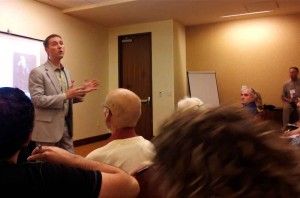These days, depression has its gray fingerprints all over modern society. It is the leading cause of disability worldwide in terms of lost work and drains the U.S. economy alone of an estimated $36.6 billion per year. By 2030 the World Health Organization expects depression to be the most damaging illness — socially and economically — in upper-income countries, outdone in other nations only by HIV/AIDS and childhood mortality.

Despite these statistics, cultural stigmas surrounding mental illness and the lack of resources allocated to address the problem mean that as many as half of those afflicted never receive treatment, according to the WHO. In a report released last October, United Nations Secretary-General Ban Ki-moon took the opportunity to call for a more honest and open dialogue about depression, what he called an “under-appreciated global health crisis.”
Biologist, author, and former depression-sufferer Lewis Wolpert struggled to do that in his 1999 book Malignant Sadness. Trying to describe the extreme seriousness of the illness, he wrote that “normal sadness is to depression what normal growth is to cancer.
“Severe depression borders on being beyond description,” he continued. “It is a quite different state, a state that bears only a tangential resemblance to normal emotion.”
Symptoms include a long list of maladies such as sadness, numbness, dullness, apathy, suicidal thoughts, crying spells, irritability, anger, insomnia, lethargy, hallucinations, delusions, difficulty concentrating or making decisions, hopelessness, loss of self-esteem, anxiety, hypochondria, loss of interest, inability to feel pleasure, and on and on.
But perhaps the strangest thing about depression is that despite hundreds of millions of dollars sunk into research and treatment over the years, and the seeming discovery of one miraculous drug after another, the illness is still a growth industry in this country.
Either there is something in the metaphorical water or there is a serious problem with the way mental illness is diagnosed and treated. Or both.
********
What lies behind that epidemic is the million-dollar question. Trauma, genetics, substance abuse, environmental toxins, and food allergies can all cause depression; radiation from power lines and cell phones continues to be studied as a possible contributor.
However, as psychiatry’s bible, the Diagnostic and Statistical Manual of Mental Disorders, has continued to widen the definitions of who should be considered sick, the medical response has narrowed. Drugs have become the first –– and frequently the only –– prescription offered by psychiatrists. In our quick-fix culture, people frequently don’t even take the time to consult a psychiatrist, going instead to the family doctor with specific Google-informed drug requests.
In November 2006, the so-called Star-D study, the largest study of treatment-resistant depression ever undertaken, showed that even after multiple medications and behavioral therapy, modern psychiatric practice could bring only two-thirds of sufferers to full remission. Continued studies of that data suggest the remission rate one year after treatment is far less than that. Published in the American Journal of Psychiatry, the study, funded by the National Institute for Mental Health, was a major embarrassment for the profession.
“I see lots of people who get put on antidepressants and anti-anxiety medications a couple days after a death in the family, by their primary-care docs,” said Austin-based psychiatrist Dr. William M. Konyecsni. “Well, feeling sad after a death is normal. I’ve also had parents give their kids their medication, and they don’t think twice about it –– and we’re talking things like Klonopin and Xanax. I mean, we have to experience and feel things to learn and grow. Not all of it is bad.”
These powerful chemicals change the way people’s brains work, and not just in ways that address the problems they were intended to remedy. Some people have begun to challenge the long-term implications of that practice.
“In the last 30 years, we’ve greatly expanded the boundaries –– or psychiatry has –– of what is considered ‘ill.’ More people are getting treated, too. From a societal point of view, you want to ask: Is that a good thing?” said author Robert Whitaker. “Are they better off five years later, 10 years later? … Are they in less psychological distress? Unfortunately, the evidence is just not there.”
Whitaker is an investigative journalist who’s become a burr under the saddle of Big Pharma. He writes in his most recent book, Anatomy of an Epidemic: Magic Bullets, Psychiatric Drugs, and the Astonishing Rise of Mental Illness in America, that the long-term outcome is actually worse for those placed on psychiatric drugs. Though his work has historically stressed the troubling history of antipsychotics and schizophrenia, Anatomy unearths numerous case studies that show similar patterns in the popular treatment of anxiety, depression, and bipolar disorder.
He believes that while drugs may help with the symptoms of depression in the short term, they can actually keep people from recovering from their initial depressed state, drawing out their experience of depression into a chronic and more difficult condition.
“That does not mean nobody is doing well on the drugs. People are,” he said. “It’s just that it doesn’t improve their recovery rates [in the long-term]; it actually worsens their recovery rates.”
Whitaker’s ideas have found fertile soil among supporters of nonpharmacological approaches to mental-illness treatment, those who subscribe to the antidepressant effects of everything from movement and dance to prayer and meditation, acupuncture, yoga, powerful vitamins, and pulsed magnetic fields. A handful of psychiatrists are also starting to take notice.
At the National Alliance on Mental Illness annual conference earlier this year, Dr. W. Clay Jackson, assistant professor of psychiatry at the University of Tennessee, issued a stirring critique of rampant “biological reductionism” — the belief that every mental disorder has its own corresponding chemical compound that can “fix” it.
“I think we’ve made two grand mistakes in approaching mental health in this country,” he said. “We have stigmatized persons who have mental illness, and we have separated it from biological illness.
“It’s led to an explosion of pharmacotherapeutic options,” Jackson said, “but it’s [also] led to a relative paucity of nonpharmacologic options for patients to follow.”
Among the less-heralded approaches are some whose results are only now getting nods from Western medicine. The literature increasingly confirms the folk wisdom about exercise, sunlight exposure, social and spiritual networks, and good diets. Beyond that, researchers have found that “yoga nidra” –– a deep sleeplike state of meditation — increases the levels of the neurotransmitter dopamine by 65 percent. Like serotonin, which is increased by many antidepressant drugs, dopamine is associated with feelings of pleasure. The old herbal standby St. John’s wort has proven to be an effective antidepressant. And as our understanding of the body’s bioelectrical nature grows, we can now add pulsing magnetic fields to that pile of proven depression-busters.
********












I hope foremost that you are feeling better. Secondly I would like to tell you that for all of the lovely things that bioenergetics can do, there is the opposite extreme which can also be created using this technology when TMS electrodes are implanted. Not only can depression be cured with tihs technology, it can be created. Like your computer, your brain can be hacked with TMS implants. Like a human RFID tag, your thoughts in the form of eeg readings can be captured by cellphone and translated into readable phrases. Additionally, you can be rendered unconscious and/or sleep deprived. Every nerve in your body can be controlled by your hacker and his buddies and then their buddies and so on. Pain becomes the norm.
Freedomfchs is a website where thousands of people meet to discuss what appears to be a very large nonconsennsual experiment in social control with this same or similar technlogy. The Psychiatric industry is a greater than 300 billion dollar industry. As you said, must be something in the water, and remember that nanotech can’t be seen with a hospital microscope but requires electron microscopy not standard in hospitals. We can’t all be crazy and yet we’re certainly being painted to look that way.
I hope foremost that you are feeling better. Secondly I would like to tell you that for all of the lovely things that bioenergetics can do, there is the opposite extreme which can also be created using this technology when TMS electrodes are implanted. Not only can depression be cured with tihs technology, it can be created. Like your computer, your brain can be hacked with TMS implants. Like a human RFID tag, your thoughts in the form of eeg readings can be captured by cellphone and translated into readable phrases. Additionally, you can be rendered unconscious and/or sleep deprived. Every nerve in your body can be controlled by your hacker and his buddies and then their buddies pand so on. Pain becomes the norm.
Freedomfchs is a website where thousands of people meet to discuss what appears to be a very large nonconsennsual experiment in social control with this same or similar technlogy. The Psychiatric industry is a greater than 300 billion dollar industry. As you said, must be something in the water, and remember that nanotech can’t be seen with a hospitalized microscope but requires electron microscopy not standard in hospitals. We can’t all be crazy and yet we’re certainly being painted to look that way.
I hope foremost that you are feeling better. Secondly I would like to tell you that for all of the lovely things that bioenergetics can do, there is the opposite extreme which can also be created using this technology when TMS electrodes are implanted. Not only can depression be cured with tihs technology, it can be created. Like your computer, your brain can be hacked with TMS implants. Like a human RFID tag, your thoughts in the form of eeg readings can be captured by cellphone and translated into readable phrases. Additionally, you can be rendered unconscious and/or sleep deprived. Every nerve in your body can be controlled by your hacker and his buddies and then their buddies pand so on. Pain becomes the norm.
Freedomfchs is a website where thousands of people meet to discuss what appears to be a very large nonconsennsual experiment in social control with this same or similar technlogy. As you said, must be something in the water, and remember that nanotech can’t be seen with a hospitalized microscope but requires electron microscopy not standard in hospitals. We can’t all be crazy and yet we’re certainly being painted to look that way.